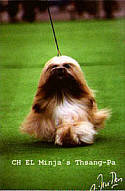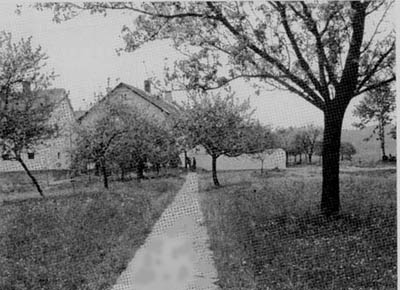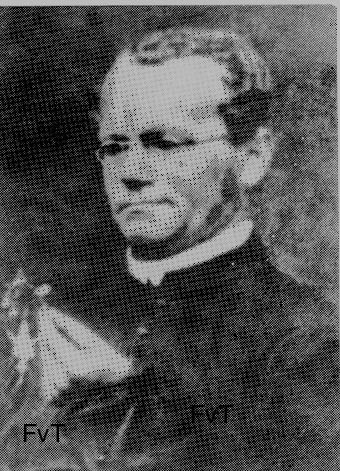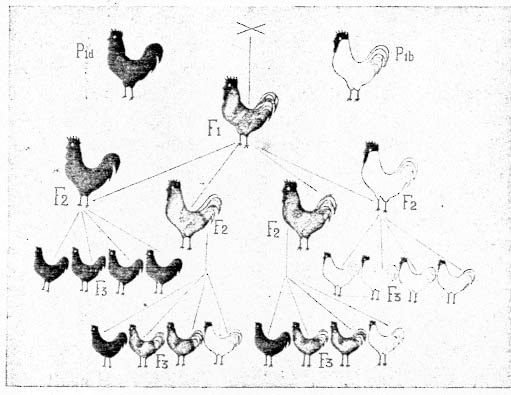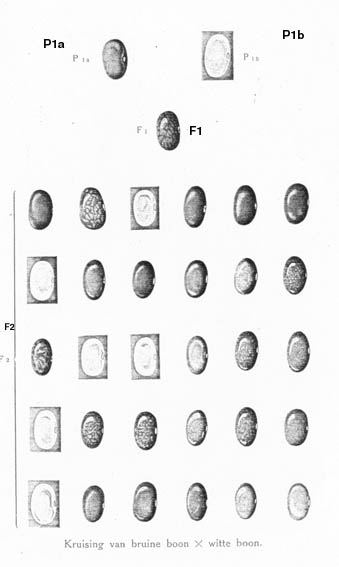Gregor Mendel
Born 22 july 1822 , died on january 6th 1884. Even though I had to go through a number of bitter times in my life, I must thankfully own that the pleasant and the good prevailed. My scientific work brought me a great deal of satisfaction, and I am convinced that it will not be long before the whole world acknowledges it. G.Mendel, 1883
To the family of a peasant liable to, corvee, A. Mendel, an only son was born on 22. 7. 1822, following two daughters; he was to have followed in his father's footsteps. This industrious peasant farmer had, for that period, a remarkable interest in breeding new fruit tree varieties, and this interest stayed with his son for the rest of his life. The educated parish priest J. Schreiber taught in the village school, and had originally been a teacher at the then unique private educational institute in nearby Kunin. He was a pioneer there in the teaching of natural science in connection with its practical application, an activity for which he was later persecuted. In 1816 Schreiber was elected as a corresponding member of what was then the Moravian and Silesian Society for the Furtherance of Agriculture, Natural Science and Knowledge of the Country (here in after Agricultural Society) on account of his exceptional pedagogical activity, and for his merits in promoting fruit-tree growing. In the house where Mendel was born at Hyncice, which is now part of the village of Vrazne in the Novy Jicin District, there is a memorial to the founder of genetics built by the Regional Museum in Novy Jicin. On Schreiber's suggestien, in 1833 A. Mendel sent his son to the Priasist school in LIpnik. from where he went on to, the Grammar School in Opava,where he consistently had the best grades. By private tutoring he assured the funds necessary for his studies. The exceptional merit of Schreiber in the modernization of the agriculture was noted in 1800 by CH C Andre. As the editor of specialized journal, Andre had been striving since the beginning of the 19th century to get the latest knowledge of natural science applied to agriculture and to the industrial production, then in its infancy. He was fascinated by the pioneer work then in progress in the selection of sheep for wool production wich had been introduced in Hostice by kromeriz by F. Geisslern (1751-1824), who followed the example of the english breeder R Bakewell (1725-1795). In 1814 Andre founded in Brno a sheep-breeder society. two years later his son Rodolf published a book wich was landmark in the development os the technique of sheep breeding. The exceptional merit of Schreiber in the modernization of school teaching and the development of agriculture was noted in 1800 by the later secretary of the Agricultural Society, Ch. C. Andre. As the editor of specialized journals, Andre, had been striving since the beginning of the 19th century to get the latest knowledge of natural science applied to agriculture and to industrial production, then in its infancy. He was fascinated by the pioneer work then in progress in the selection of sheep for wool production, which had been introduced in Hotice by Kromotic by F. Geisslern (1751-1824), who followed the example of the English breeder R. Bakewell (1725-1795).
G. Mendel, the earliest known photograph. Detail from a group of Augustinians, 1848 During his theological studies Mendel also attended recommended lectures on agriculture and fruit-tree growing by F. Diebl (1770-1859). From 1825 to 1849 Diebl taught agriculture and natural science at the Philosophical Institute in Brno,. From 1827 to 1832 he was Custodian of the Brno museum. He was a notable expert on agriculture and made a particularly significant contribution to the promotion of pomology. He was also appreciated as a plant-breeder. In his published papers he advocated the use of modern methods in agricultural production. He also described the technique of artificial fertilization, considering it the most important method in plant breeding. In the 1830s Diebl was associated with Napp as the secretary of the Pornological Society, taking part in the announcement of prize essays on the breeding of new plant varieties through artificial hybridization. In 1839 the gardener J. Tyrdc won a prize for breeding a new variety of currant-bush and describing the method applied. After his dead on january 6th 1884, the merits of the deceased abbot were appreciated in Brno. At the same time he was acknowledge as an important official in public institutions and scientific societies. Only the horticulturists recalled Mendel's epoch-making, experiments with plants hybridization. His scientific papers on plant hybrids remained , however, without recognition until the end of the century. In the 1880s A. Weismann was already showing the material of the nucleus to be the carrier of heredity. Thus he encourage other scientist to do research on heredity in connection with the structure and function of the chromosome. In 1900 attention was drawn to Mendel's work by Hugo de Vries in Holland and by C. Correns in Germany. To their voices was later added that of E. Tschermak of Vienna, who was the instigator of the application of Mendel's theory in plant breeding. In 1910 Tschermak founded in Lednice in Moravia a research institute for plant breeding called the Mendeleum. At the time E. Proskowetz in Kvasice and J. Vailha in Brno were elaborating modern methods of cereal breeding. After 1900 Mendel's Pisum paper was said to have been rediscovered, and began to be considered the basis of the study of the principles of heredity in plants, in animals and in Man. In 1906 Bateson called the teaching of heredity "genetics", and in 1909 W. johannsen named the unit of heredity the "gene". In 1910 a memorial was raised in Brno to Mendel, the building of which was supported by prominent researchers from abroad. The occasion of the centenary of Mendel's birth in 1922 was commemorated with an international scientific gathering in Brno.In 1910 Morgan demonstrated the gene to be a part of the chromosome structure.
Crossbreed, data from Bateson, 1906, black X white Andalusian chicken Blue F1, splitting F2
Crossbreed brown bean with white beans, Tschermak, 1912 The anniversary of Gregor Mendel's birth reminds us and all scientists abroad to celebrate this day at the very place of the scholar's activity a duty to which all of us are bound in honour. Invitation to the Gregor Mendel Centenary, 1922.
|
